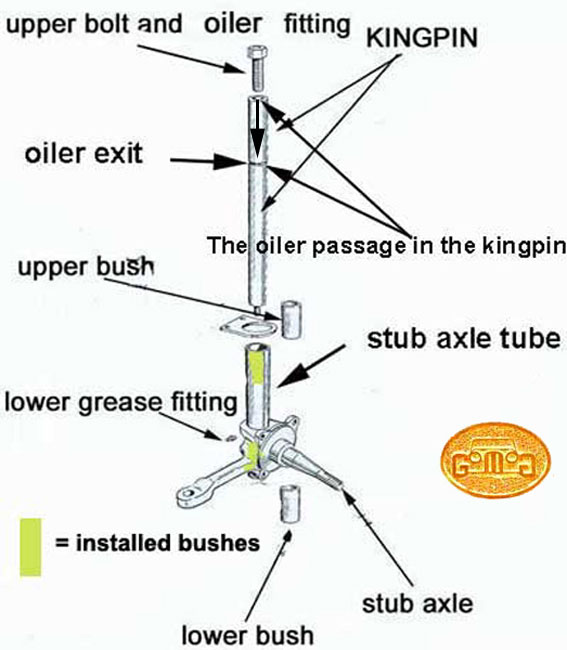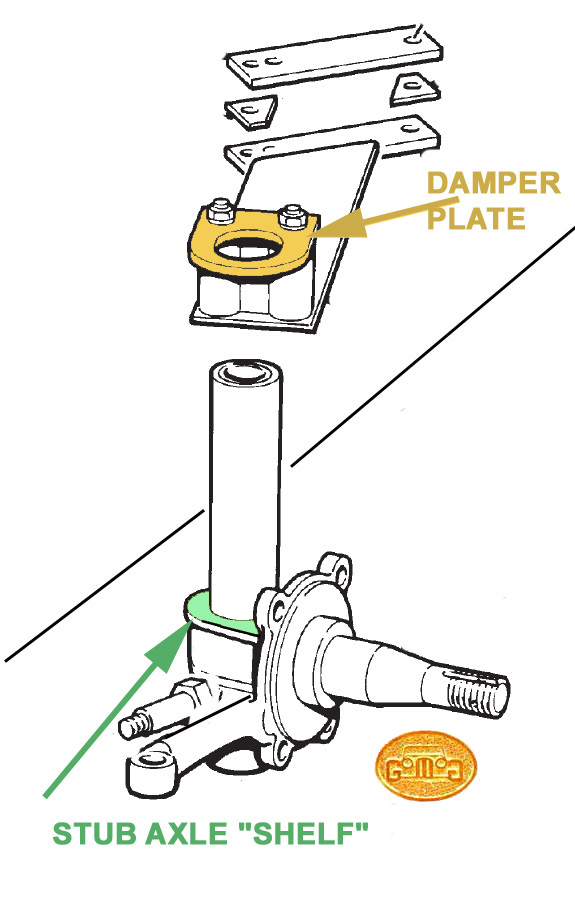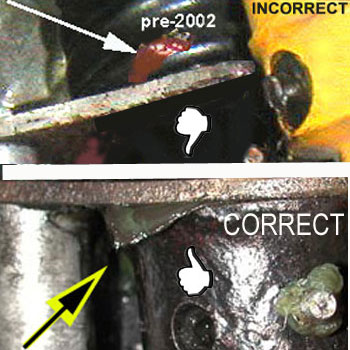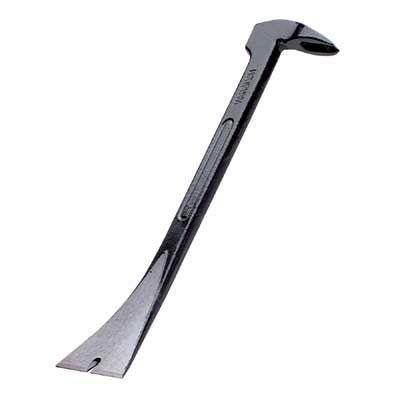GREASING MORGAN FRONT SUSPENSIONS
(1950 to 2000)
by Lorne Goldman
MAKE SURE YOU HAVE PICKED THE RIGHT GREASING ARTICLE
FOR YOUR MODEL YEAR ! YOUR CHOICES CAN BE FOUND HERE
UNDER "FRONT SUSPENSION GREASING".
The bushes fit in the stub axle tubes, one at the top
and the other at the bottom of the stub axle tube. As they do not fill
the entire length of the tube, a grease reservoir or "grease holding area"
is formed between the two bushes. As the stub axle slides up and down the
kingpin, this reservoir  greases the kingpin (and therefore the bushes). The stub axle has a grease
nipple exactly adjacent to the middle of this reservoir to service and
fill this area periodically. The Factory manuals in the period suggested
this be done every 5000 miles but this has been proven to be insufficient.
We recommend 1500 mile intervals (greasing more doesn't do anything beneficial
I can think of and makes a mess). [Since 2006 the Factory Manuals reflect
our suggested mileage interval.]
greases the kingpin (and therefore the bushes). The stub axle has a grease
nipple exactly adjacent to the middle of this reservoir to service and
fill this area periodically. The Factory manuals in the period suggested
this be done every 5000 miles but this has been proven to be insufficient.
We recommend 1500 mile intervals (greasing more doesn't do anything beneficial
I can think of and makes a mess). [Since 2006 the Factory Manuals reflect
our suggested mileage interval.]
 Greasing
can be done with the car on the ground or on jack stands. A one hand "pistol"
greaser can be used. (When I am home, I use a powerful electric grease
gun equipped with a flex hose. The device effectively creates an extra
hand which makes the job easier.) The grease nipple angle can make it hard
to properly center the grease gun but the angle of the grease nipple can
be changed to suit, or alternatively buy an angled nose for your grease
gun. A slight angle will do.
Greasing
can be done with the car on the ground or on jack stands. A one hand "pistol"
greaser can be used. (When I am home, I use a powerful electric grease
gun equipped with a flex hose. The device effectively creates an extra
hand which makes the job easier.) The grease nipple angle can make it hard
to properly center the grease gun but the angle of the grease nipple can
be changed to suit, or alternatively buy an angled nose for your grease
gun. A slight angle will do.
1. Turn the steering wheel until you have the best angle
at the nipple,
2. Pry up the damper plate to allow for a freer flow under
the plate. This is the way the Factory Service Department has done it for
60 years. (Confidence in the one-shot  oiler
was not high amongst the MMC service staff from the start.) There is a
little passage from the grease reservoir between the bushes to the "shelf"
the damper plate sits on. It is important this shelf be lubricated by the
grease and prying it up prevents it from blocking the grease flow. Without
it, steering can become heavy and damper plate wear is accelerated, which
can force you to a front suspension rebuild prematurely.
oiler
was not high amongst the MMC service staff from the start.) There is a
little passage from the grease reservoir between the bushes to the "shelf"
the damper plate sits on. It is important this shelf be lubricated by the
grease and prying it up prevents it from blocking the grease flow. Without
it, steering can become heavy and damper plate wear is accelerated, which
can force you to a front suspension rebuild prematurely.
3. Pump until the grease flows out under the damper plate
(which sits on the stub axle shelf.). (That takes a lot of pumps!)
If the grease flows out the bottom of the assembly, it is a sign that your
car is due for a front end bush and kingpin renewal. See the articles in
this Manual
on
that. If you see the grease exiting from the lower rungs of the Main Spring
above the axle, the likelihood is that you have not greased the underside
of the damper plate, a task as important as filling the reservoir. You
have either not bothered to lift the damper plate or have not done it sufficiently.
4. Turn the steering wheel and do the other side.
5. Clean away any excess with a rag and, if necessary,
brake cleaning spray. If any grease gets on your adjacent brake rotors,
the effect on braking and steering is dangerous.
 AN ADDENDUM (revisited by request on June 10, 2023) AN ADDENDUM (revisited by request on June 10, 2023)
by Lorne Goldman, Bill Beck and George Dow.
Prying
up the plate. (updated in August 2011) Though this element has been
a given for many years, I have recently received some inquires on this
procedure and whether it is necessary. Worries were expressed as to damaging
the damper plate. I take this as evidence that there are many new Morgan
owners and/or more people are doing home maintenance. Great!
The answers for the why's of prying the plate up are simple
as the Morgan front itself. One has to only see and understand the basics
of the suspension and its few components. This is not complicated unless
you are wrongly convinced it is so. Far too much is made of this area of
the cars. Unlike the rear suspension, there is not much one can do at the
front to
improve it save to correct minor errors in that crept in at the Factory
over time and more importantly, inadequate maintenance after sale.
Redesigns in stub axle or the plate solved the problem of
inadequate greasing
by owners as the later steering races solved the problem of inadequate
damper blade adjustment by eliminating them.
Again, prying the plate
up is only necessary for Morgans made pre-2000 or those who have kept their damper blades after installing STEERING BEARINGS. The plate can be pried up with a pry up with a "pry" or
a big flathead screwdriver. This is the preferred method, the one I used to use when I had damper blades.
Ignore your concern that this will "break something" or "damage"
the bottom of the plate. The plate is made of bronze, a
sacrificial metal. At worse, if scratched it will retain more grease, which
is a good thing. Those with pre-2000 Morgans who wish
to forego lifting the plate can buy plates with annular grooves carved
in THEM or have a machine shop do so without risk. See the image. (Note
the groove's three cuts to the center allowing this groove to be fed from
the pre-2000 grease exit at the sub axle tube.)
The consequences of NOT greasing this area properly is
heavy steering and a quick wear of the damper plates which will exaggerate
the steering difficulty even more. Though these plates are not expensive,
the front end must be disassembled completely to change them.
|
| WATCHPOINT I: The incorrect grease nipples. have received many notes on the
difficulties owners are having pumping grease into the stub axles in front.
At first I thought it was the grease gun they chose, but I soon found the
problem was even more basic. Many owners change the stub axle grease nipple
(zirk) for angled ones which allow an easier time fitting their grease
gun onto it. Sadly, they do not notice that the threaded portion of the
Morgan grease nipple is short..shorter than most available. When they fit
the new nipples they often thread them until they are forced into the kingpin.
This blocks the flow of grease despite the use of eye-popping pressure.
The front gets little of its needed grease feed and the kingpin can be
damaged. |
WATCHPOINT II Seized Kingpins Morgan kingpins can seize. This happens more often with;
1. Some DEVOL cars
2. Those left in long storage and little usage
3. Those with improper front end installation..poorly aligned bushes or an improper clearance between bushes and kingpin.
When
Morgans seize in the front, the suspension is effectively eliminated,
severely prejudicing the comfort and handling of the car. The front
end should be tested for seizure each time it is greased. This is a
simple procedure. Place a trolley jack under the middle of the
crossmember. Jack up the car while watching each stub axle assembly in
turn. Do to springs compress? Or does the car simply rise without the
springs compressing? |
 greases the kingpin (and therefore the bushes). The stub axle has a grease
nipple exactly adjacent to the middle of this reservoir to service and
fill this area periodically. The Factory manuals in the period suggested
this be done every 5000 miles but this has been proven to be insufficient.
We recommend 1500 mile intervals (greasing more doesn't do anything beneficial
I can think of and makes a mess). [Since 2006 the Factory Manuals reflect
our suggested mileage interval.]
greases the kingpin (and therefore the bushes). The stub axle has a grease
nipple exactly adjacent to the middle of this reservoir to service and
fill this area periodically. The Factory manuals in the period suggested
this be done every 5000 miles but this has been proven to be insufficient.
We recommend 1500 mile intervals (greasing more doesn't do anything beneficial
I can think of and makes a mess). [Since 2006 the Factory Manuals reflect
our suggested mileage interval.]
 Greasing
can be done with the car on the ground or on jack stands. A one hand "pistol"
greaser can be used. (When I am home, I use a powerful electric grease
gun equipped with a flex hose. The device effectively creates an extra
hand which makes the job easier.) The grease nipple angle can make it hard
to properly center the grease gun but the angle of the grease nipple can
be changed to suit, or alternatively buy an angled nose for your grease
gun. A slight angle will do.
Greasing
can be done with the car on the ground or on jack stands. A one hand "pistol"
greaser can be used. (When I am home, I use a powerful electric grease
gun equipped with a flex hose. The device effectively creates an extra
hand which makes the job easier.) The grease nipple angle can make it hard
to properly center the grease gun but the angle of the grease nipple can
be changed to suit, or alternatively buy an angled nose for your grease
gun. A slight angle will do.
 oiler
was not high amongst the MMC service staff from the start.) There is a
little passage from the grease reservoir between the bushes to the "shelf"
the damper plate sits on. It is important this shelf be lubricated by the
grease and prying it up prevents it from blocking the grease flow. Without
it, steering can become heavy and damper plate wear is accelerated, which
can force you to a front suspension rebuild prematurely.
oiler
was not high amongst the MMC service staff from the start.) There is a
little passage from the grease reservoir between the bushes to the "shelf"
the damper plate sits on. It is important this shelf be lubricated by the
grease and prying it up prevents it from blocking the grease flow. Without
it, steering can become heavy and damper plate wear is accelerated, which
can force you to a front suspension rebuild prematurely.
